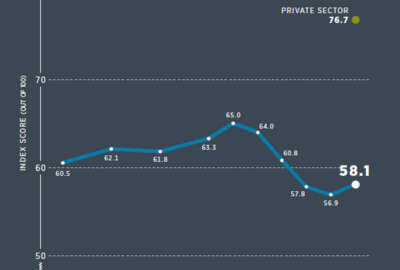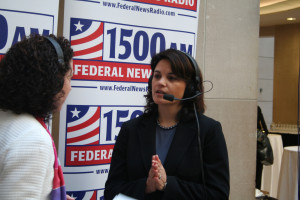
Exclusive
HUD begins to earn back employee respect
Nani Coloretti, the HUD deputy secretary, said the 8 point increase in the 10th annual Best Places to Work rankings can be traced to listening to employees and...
The Department of Housing and Urban Development jumped 8 points in the annual Best Places to Work survey. It was the largest increase among all the mid-sized and large agencies in the rankings.
While HUD still has a long way to go to fix employee engagement — it’s ranked 21 out of 24 among agencies with 1,000 to 14,999 employees — officials believe the battleship is indeed turning in the right direction.
Nani Coloretti, the HUD deputy secretary, said Secretary Julian Castro and other top executives were surprised by the large increase, but were hopeful that the needle would finally move in the right direction.

Coloretti said one reason for the jump came down to basic participation in the Employee View Point Survey conducted by the Office of Personnel Management, which the Best Places to Work rankings are based upon to a large extent.
“We did something that was really bold,” Coloretti said in an exclusive interview with Federal News Radio. ” We set a very high goal for participation in this survey, for our response rate. When we heard that when you have a 51 percent response rate and when you have such a low score, it was hard to know if that was really the place we worked at or not. So we asked everybody and really pressed the agency to respond and talked about ways in which we would use the responses to make this a better workplace. We got our response rate up to 74 percent. Our goal was 75 percent. We didn’t expect to get even near that goal. We feel like that helped because just that in and of itself means we were serious about engagement and wanted to hear from people.”
The Partnership for Public Service released the 10th annual rankings Dec. 8.
HUD has seen significant drops in its score since 2011 and steady decreases since its high water mark in 2009 of 58.0 points out of 100.
The progress to improve employee engagement and morale becomes more clear at the component levels.
The Partnership for Public Service found 12 of 13 components saw increases — some were significant, such as Office of Policy Development and Research increasing by 11.5 points, while the Office of the Chief Procurement Office inched up by 0.7 points.
Under former Secretary Shaun Donovan, who now is the director of the Office of Management and Budget, the focus on engagement and morale started. Castro and Coloretti continued the listening tour across the country.
Coloretti said she and other executives have been on a “deep dive” tour with each operational area across HUD and throughout the country.
This is on top of using two internal crowdsourcing tools: HUD Connect and Switchboard.
“When I think about how to make a stronger HUD, I really focused on the capacity of the agency. HUD has a very strong mission and it’s one of our biggest strengths,” she said. “One of our goals is to end veterans’ homelessness. We are working on really hard, really important things that are clear to understand and hard to do. What was challenging to people was the lack of capacity, that is really a focus on our systems, our processes and our people. What I found out through our deep dive was just a critical need to address every operational area.”
Through those conversations, Coloretti said she heard time-and-again that the hiring planning process was a “critical pain point.”
She said it could take up to 84 days just to plan to hire someone, and that doesn’t include the actual hiring of personnel.
“We actually brought in Toyota, which does a lot of lean process improvement and worked side-by-side with a bunch of career staff who do this work all the time and they got the hiring plan process down from 84 days to 12,” Coloretti said. “The deep dive is really a deep dive. It’s basically looking at the processes and elements of capacity that need to be improved and we really have a project in every operational area that you could imagine.”
Reducing the time-to-hire is next. She said by mapping the hiring planning processes, HUD learned a lot about how they think about positions and how they describe and post the jobs.
The two crowdsourcing tools — HUD Connect and Switchboard — let employees communicate back to the executives, making the effort both top down and bottom up.
The Switchboard tool lets employees submit ideas for changes, and vote on them. Coloretti said she reviewed any idea that received more than 200 votes.
“One idea that got a lot of votes was for us to do more succession planning, which is interesting because most people see planning and run for the hills,” she said. “But here at HUD people wanted us to be more proactive. So, we became the first cabinet agency to launch the phased retirement program.”
HUD opened its phased retirement program in September.
Coloretti said a major piece to HUD’s effort is communication. She said whenever the agency would accomplish something, Castro or another executive would send an email out or put the news out in a forum on HUD Connect. With about two-thirds of its staff outside of Washington, Coloretti said providing real-time communications about what is happening and when helped employees realize their ideas were making a difference.
Coloretti said the 18 ongoing projects as part of the deeper dive effort is part of how she plans to sustain and build on the progress.
“The way the projects we are doing in the deep dives and the engagement plans themselves are structured is really leaning on the career leadership at HUD,” she said. “There’s a whole set of work streams around bolstering leadership both in the SES and through the management ranks. If you think of capacity as people, processes and systems, and I only have a year left, I’m just going to focus on people because that’s who is going to do the other things.”
Copyright © 2025 Federal News Network. All rights reserved. This website is not intended for users located within the European Economic Area.
Jason Miller is executive editor of Federal News Network and directs news coverage on the people, policy and programs of the federal government.
Follow @jmillerWFED



